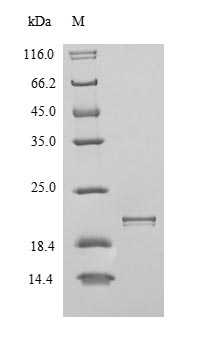The gene sequence encoding the human ITGAV antigen from residues 891 to 1048 is linked to an N-terminal 6xHis tag gene to create a target gene. After PCR amplification, this target genes are inserted into expression vectors to form recombinant plasmids. These plasmids are transformed into yeast cells, which are cultured to induce protein expression. The culture supernatant is then collected and purified by affinity chromatography, yielding the recombinant human ITGAV protein with a purity greater than 90%, confirmed by SDS-PAGE.
ITGAV is a crucial member of the integrin family, which plays significant roles in various biological processes, including cell adhesion, migration, and differentiation. ITGAV is known to heterodimerize with various beta subunits, such as β1, β3, and β5, forming integrin complexes that mediate interactions with the extracellular matrix (ECM) [1][2]. These interactions are vital for cellular functions and are implicated in numerous physiological and pathological processes, including cancer progression and tissue regeneration.
In the context of cancer, ITGAV has been shown to influence tumor cell behavior significantly. Elevated expression of ITGAV is associated with increased cell proliferation, migration, and metastasis in various cancers, including breast and liver cancers [3][4]. In breast cancer, suppression of ITGAV led to decreased cell proliferation and migration, indicating its role as a potential therapeutic target [4]. Similarly, in hepatocellular carcinoma, ITGAV transcription is upregulated, promoting cancer cell invasiveness [1]. The expression of ITGAV is also linked to poor prognosis in several epithelial tumors, highlighting its potential as a biomarker for cancer aggressiveness [2].
Moreover, ITGAV is involved in the differentiation of stem cells, particularly in adipose-derived stem cells. Studies have demonstrated that silencing ITGAV enhances adipogenic differentiation, suggesting that it plays a regulatory role in stem cell fate decisions [5][6]. This regulatory function is further supported by findings that ITGAV is essential for the maturation of focal adhesions, which are critical for cell attachment and signaling [6]. The interaction of ITGAV with ECM components, such as fibronectin, also underscores its importance in maintaining cellular architecture and function [7].
ITGAV is also implicated in immune responses and inflammation. ITGAV has been shown to mediate interactions between immune cells and the ECM, influencing processes such as T-cell activation and regulatory T-cell function [8]. The modulation of ITGAV expression can impact inflammatory responses, making it a potential target for therapeutic interventions in inflammatory diseases [9].
References:
[1] C. Kang, B. Qi, Q. Cai, L. Fu, Y. Ying, C. Tang, et al., Lncrna ay promotes hepatocellular carcinoma metastasis by stimulating itgav transcription, Theranostics, vol. 9, no. 15, p. 4421-4436, 2019. https://doi.org/10.7150/thno.32854
[2] H. Löser, M. Scholz, H. Fuchs, A. Essakly, A. Damanakis, T. Zander, et al., Integrin alpha v (itgav) expression in esophageal adenocarcinoma is associated with shortened overall-survival, Scientific Reports, vol. 10, no. 1, 2020. https://doi.org/10.1038/s41598-020-75085-7
[3] Y. Pei, Y. Zhang, K. Zheng, G. Shang, Y. Wang, W. Wang, et al., <p><em>ilex hainanensis merr</em> targets itgav to suppress the proliferation and metastasis of osteosarcoma cells</p>, Oncotargets and Therapy, vol. Volume 12, p. 4499-4507, 2019. https://doi.org/10.2147/ott.s205688
[4] M. Sarkar, M. Mia, M. Amin, M. Hossain, & M. Islam, Bioinformatics and network biology approach to identifying type 2 diabetes genes and pathways that influence the progression of breast cancer, Heliyon, vol. 9, no. 5, p. e16151, 2023. https://doi.org/10.1016/j.heliyon.2023.e16151
[5] D. Salazar-Tortosa, D. Enard, Y. Itan, & J. Ruiz, Novel brown adipose tissue candidate genes predicted by the human gene connectome, Scientific Reports, vol. 12, no. 1, 2022. https://doi.org/10.1038/s41598-022-11317-2
[6] E. Morandi, R. Verstappen, M. Zwierzina, S. Geley, G. Pierer, & C. Ploner, Itgav and itga5 diversely regulate proliferation and adipogenic differentiation of human adipose derived stem cells, Scientific Reports, vol. 6, no. 1, 2016. https://doi.org/10.1038/srep28889
[7] F. Hu, F. Gao, P. Xu, & S. Zhang, Cell development deficiency and gene expression dysregulation of trisomy 21 retina revealed by single-nucleus rna sequencing, Frontiers in Bioengineering and Biotechnology, vol. 8, 2020. https://doi.org/10.3389/fbioe.2020.564057
[8] J. Worthington, A. Kelly, C. Smedley, D. Bauché, S. Campbell, J. Marie, et al., Integrin αvβ8-mediated tgf-β activation by effector regulatory t cells is essential for suppression of t-cell-mediated inflammation, Immunity, vol. 42, no. 5, p. 903-915, 2015. https://doi.org/10.1016/j.immuni.2015.04.012
[9] Y. Lee, C. Lee, J. Bae, K. Nam, D. Moon, O. Hwang, et al., Inhibition of skin carcinogenesis by suppression of nf-κb dependent itgav and timp-1 expression in il-32γ overexpressed condition, Journal of Experimental & Clinical Cancer Research, vol. 37, no. 1, 2018. https://doi.org/10.1186/s13046-018-0943-8






